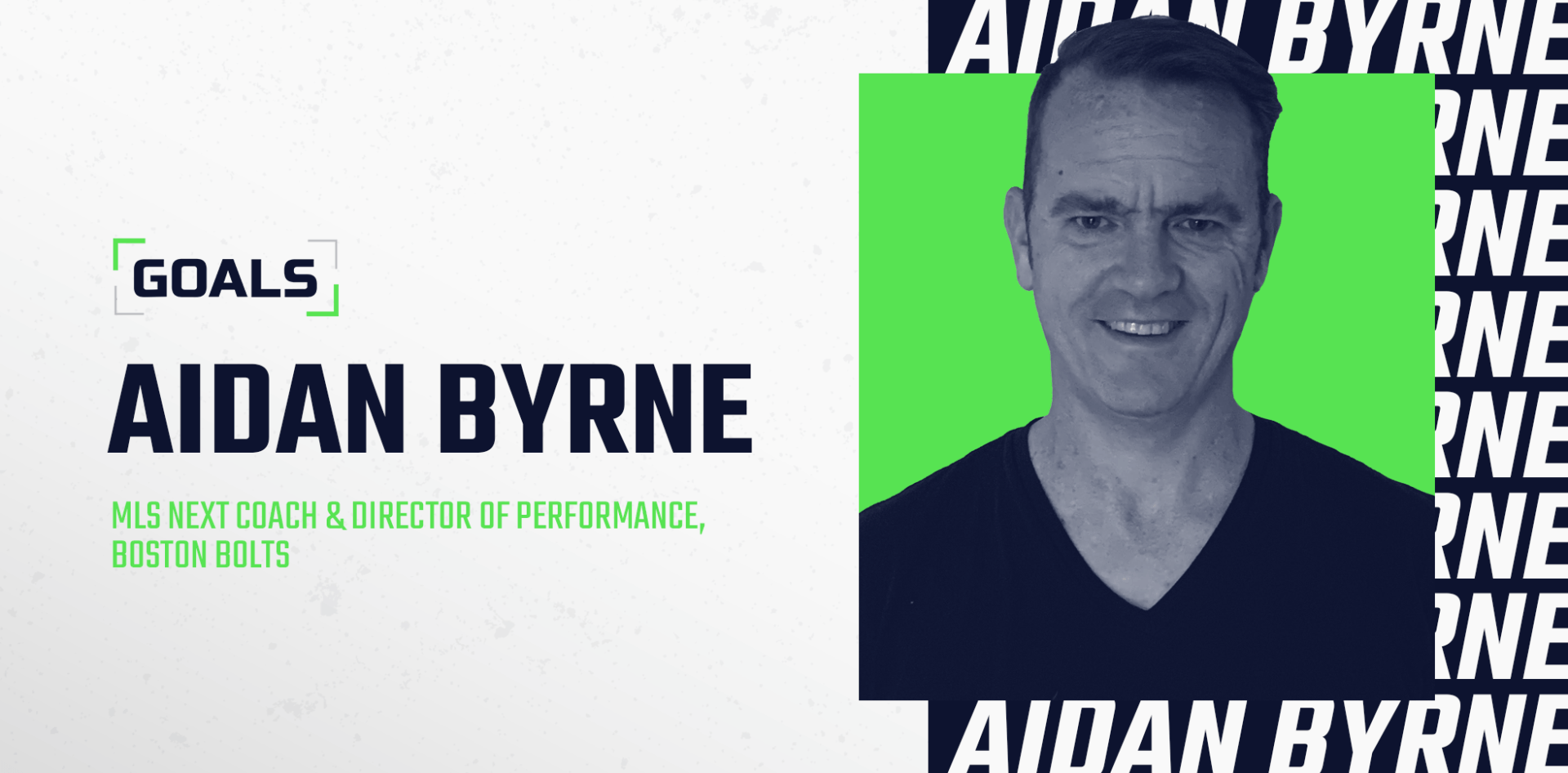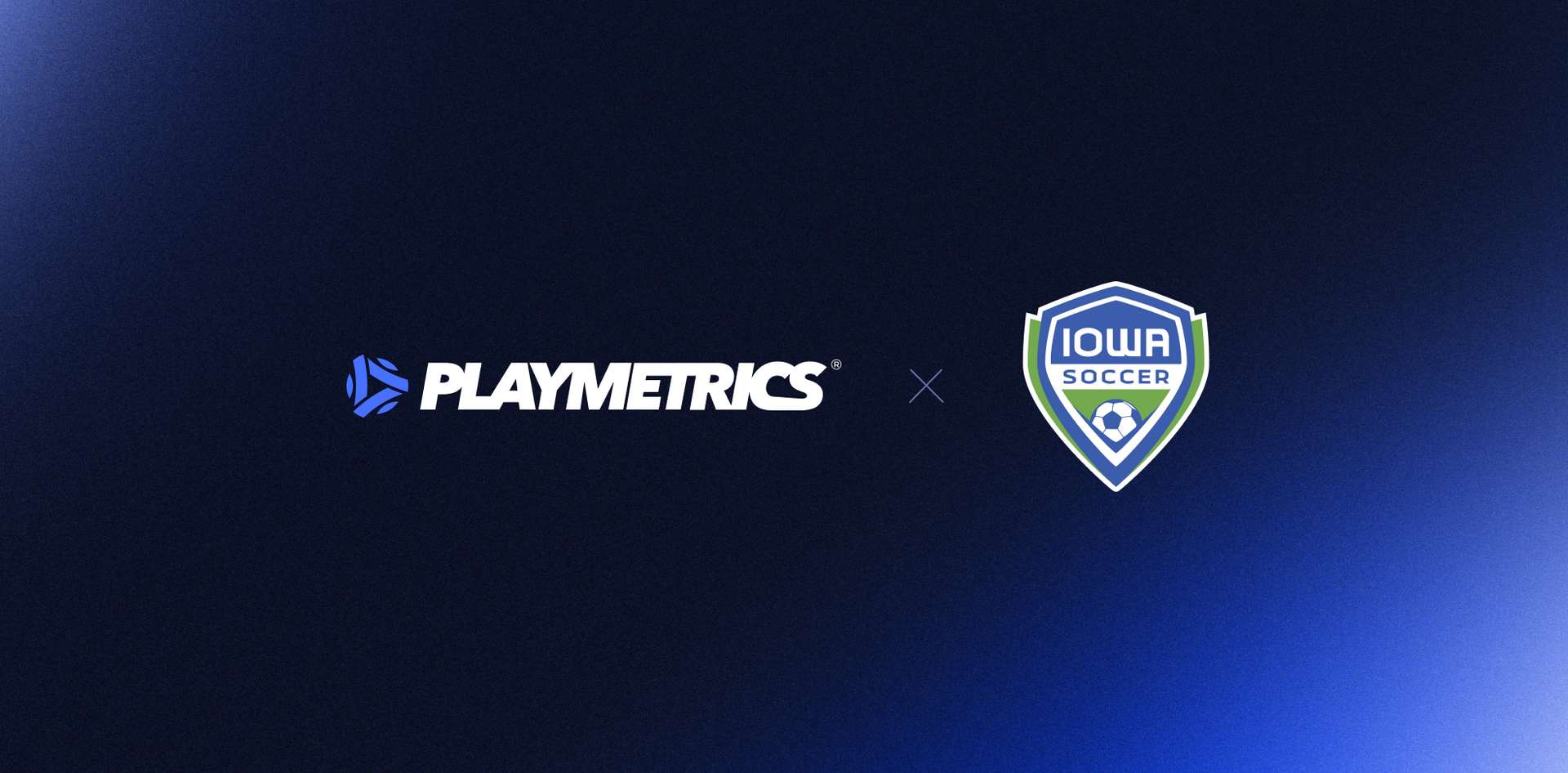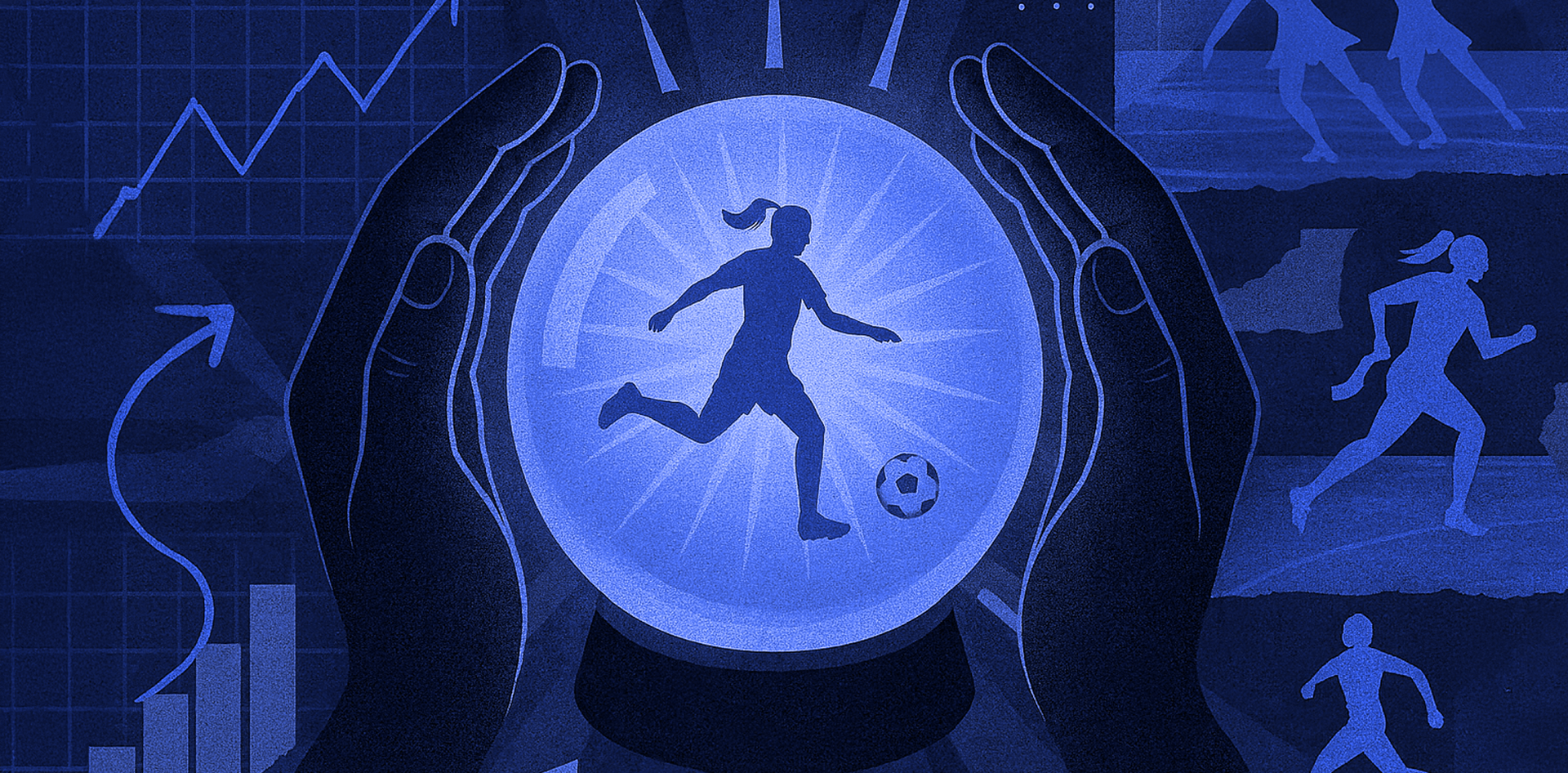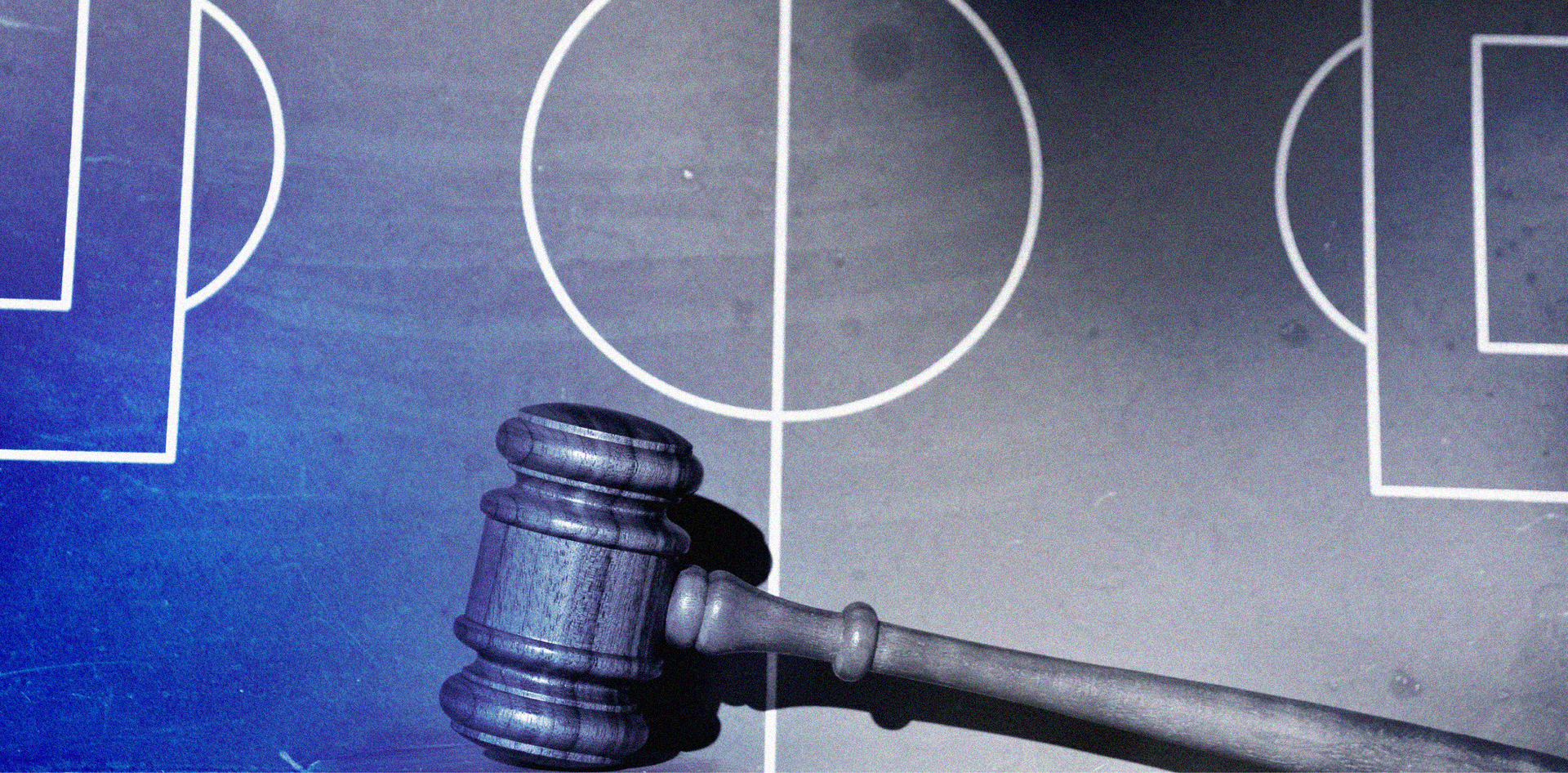When you start a conversation with Aidan Byrne, you might think you’re talking to just another trainer-slash-coach-slash-former-star-athlete. You’d be right. But you’d also be very wrong.
You see, Aidan checks all the boxes. But when you really get into it with him, you realize he thinks and operates outside of one. Aidan was never going to settle anywhere he didn’t feel challenged. His competitive nature, friends, and passion moved him multiple times, and he accumulated an impressive training and coaching portfolio. But no matter where he was, his heart was always in the right place.
As the MLS Next Coach and Director of Sports Performance with the Boston Bolts, he brings more than Xs and Os to training sessions. Sure, he easily digs into the science of how and when young soccer players should train. But he doesn’t stop at what’s best for the body. He trains the heart and mind with the same care and focus. Aidan’s work is measured in more than numbers today or stats this season. It’s about building healthy habits that will last young players a lifetime. To support his mission, he launched Total Athletic Development (TAD) as a way to reach more people with a fresh perspective on performance training in youth soccer.
In this interview, Aidan talks more in-depth about moving from Ireland, not getting a degree in physical education, connecting the dots between coaches and trainers, dropping Randy Moss for Tom Brady, and his deep belief that more isn’t always better.
When did you know soccer was the game for you?
AB: My clearest first memory of football, or soccer as it’s called here, is probably the ’83 FA Cup Final with Manchester United and Brighton & Hove Albion. I remember for Christmas, my parents bought me a Manchester United shirt, and neither of my parents were Manchester United fans. My dad played football and was pretty good at it. He played at a very high level but didn’t force it on me. When he watched it on a Saturday and Sunday, I watched it with him. And the more I watched, the more I fell in love with it. It also helped at the time that Manchester United had several Irish players on the team.
What brought you to the United States?
AB: I was in college studying to be an engineer when I got the opportunity to come over here and attend Mount Ida College, a junior college in Newton, Massachusetts. I really didn’t know anything about school here, I just came to play soccer. I wanted to be a physical education teacher so I thought I’d play football, get a degree in PE, and be back home in two years. But then, the University of Rhode Island (URI) asked me to stay. I met my wife at URI, and the rest is history. After graduation, we started back up to Massachusetts to find work. I knew I wanted to coach soccer, but I didn’t know if I wanted it to be my full-time job. I never became a PE teacher.
Why not?
AB: To be honest, at that point in my life, I knew I wanted a family one day and didn’t know if I could be corralling kids in a gymnasium all day and then have energy for my own kids when I got home. The more classes I took on the fitness side, the more I enjoyed it, so I just found my way into the fitness side of physical education and performance.
What was the first job you landed?
AB: I originally got a job in a large corporate fitness center, opening, closing, learning the trade, for want of a better phrase. I had a couple of really good mentors there. After about two and a half years, I went out on my own and set up a business in a physical therapist’s office for about 10 years doing personal and performance training for all different age groups. I was also coaching on the side and started at MIT as an assistant coach.
How long were you at MIT?
AB: I was an assistant coach at MIT for only one year because the assistant coach’s position opened up at my alma mater, Mount Ida, and I had the good fortune to go back and work with the gentleman who coached me, Steve Darcy. He was my mentor. He taught me so much about the game and coaching. I was there for about nine years. I moved on because Mount Ida became a Division III school, and being young and very competitive, I wanted to move to a higher level.
FRIENDS IN MANY PLACES
So where did young, competitive Aidan go next?
AB: A friend of mine from URI became the head coach at Siena College, so I followed him there as an assistant for a couple of years, driving back and forth from Massachusetts to Albany, NY. And then another friend of mine was the head coach at Northeastern University, much closer to home, so I took an assistant coaching job there in 2012. In 2014, I returned to MIT, but this time as head coach for one year. I wanted to be there longer, but through more networking and friends, I got an offer to be a performance coach for New York City Football Club in the MLS.
Your network of friends keeps moving you around.
AB: I was driving to New York regularly, but it was fun in the sense that I knew when I was leaving home at 5 o’clock in the morning, I was going to something that I had a passion for. And I was working with players like David Villa, Andrea Pirlo, and Frank Lampard. Eventually, I ended up working with Patrick Vieira, who was the coach my second year there. I loved the environment. It was so competitive. But it was a lot of travel, so when I got the offer to become Head of Performance with the New England Revolution under Jay Heaps, I came back to Massachusetts and spent a year with the Revolution. At the end of that year, unfortunately, Jay was let go, and then Brad Friedel came in. He brought his own staff so I was out. That’s when I got back into youth soccer with the Boston Bolts in 2018.
...I knew when I was leaving home at 5 o’clock in the morning, I was going to something that I had a passion for.
What are your official responsibilities at the Bolts?
AB: I’m the head USL League Two coach, head coach for the Under 19 MLS NEXT team, formerly known as the DA, as well as the Under 19 head coach for our ECNL group. And then I’m also the Director of Performance.
Tell us more about the club.
AB: The Bolts is a non-profit organization with about 1200 kids in the program. Our CEO is Brian Ainscough, who’s been around youth football for a long time. He grew up not too far from where I grew up, probably a 10-minute walk, and came over to the United States in a similar situation to me. The club was founded in 1986, and the CEO at the time was Johnny Kerr, who is now head coach at Duke. The club has really grown over the years. We’re the only other club in Massachusetts in the MLS NEXT besides the New England Revolution Academy.
How do you describe the differences between soccer in Europe and soccer in the United States?
AB: In Europe, it’s a way of life. It’s all people talk about. You pick a club, and you go along with it. It’s such a huge part of what goes on. Whereas over here, a lot of people love the game, but it’s not a way of life. I think it’s because there are so many other things. There’s football, baseball, basketball. I’m a fan of American football. I love it.
Patriots fan?
AB: Yes. I was originally a Minnesota fan when I first came here because I loved Randy Moss. I just thought he was an incredible athlete. Not the best role model in the world, but he just was this incredible athlete who could jump out of the air. But as time went on and I got to know more about the game and the Patriots games were on, I became a fan.
PERFORMANCE. SPECIALIZED.
What’s the difference between a trainer and a performance specialist?
AB: If you’re looking at a one-on-one soccer trainer, it’s probably somebody who is a coach, teaching kids how to trap the ball, kick the ball, play a pass 20, 30 yards. I know a lot of people will disagree with me on this, but I just don’t see the point in it. Why can’t the kid just go out into their backyard and do that? Now, if you do that collectively in a group of five or six kids, now you’re talking about something that might be worth it. Because they have to communicate with each other to play a pass, decide when to play a pass, and then execute that pass.
When it comes to a performance coach, I think a big difference is, it’s somebody who has to know that it’s not just an aerobic sport, but an intensity sport. A lot of trainers don’t realize that. They’ll make the kid run 2 miles in 12 minutes. Absolutely pointless when it comes to playing soccer. It’s so important to find the right person who knows the game, will ask the right questions of the player and the parents. For example, you come to see me on a Friday, but Friday is game day minus one. We really can’t overload the kid because there’s a game tomorrow, so we know to do a short 30-minute pre-activation session.
How do the roles of Coach and Director of Performance blend?
AB: They work together. I have an advantage, understanding the training and the loads that kids require. It’s something that I’m always cognizant of when training the kids. How much are we doing, and how will it affect the kids? I think the most important thing during the week is preparing for the game, especially the older ages, where winning becomes just a little bit more important. You can go through all of the technical and tactical stuff, but the reality is you want to make sure that when they get to the pitch on a Saturday morning for an 11 o’clock kick-off that they are fresh. That you haven’t exhausted them throughout the week, and they’re coming to you with only 70% in the tank.
Do you see a lot of coaches and clubs not getting that concept?
AB: Experienced and well-educated coaches will understand that, but not everybody who coaches youth soccer is at that level. I think there’s a tendency to think more is better, and it’s not always the case. Better is better. It’s as simple as that.
And I do see a tendency for parents and kids to push, push, push, and when you push like that, there are no gains once you go past a certain point. I’ll give you an example. You have a game on Saturday morning, and you’re training with your club Tuesday, Wednesday, Thursday, but you’re out training with a different trainer or a different group of kids on a Friday night between 9:00 and 10:30. How do you think you’re going to play on a Saturday morning when the college coach is coming to watch you? It just doesn’t work. I see this a lot where parents think if they pay for the trainer, it’ll help them, but it doesn’t always work. The reality is, you might be hurting their development.
I think there’s a tendency to think more is better, and it’s not always the case. Better is better. It’s as simple as that.
“Better is better.” Was that always your philosophy?
AB: I took a course back in 2012 with a guy by the name of Raymond Verheijen, a Dutch football coach, but I want to say he is a football philosopher. Controversial in many respects. I listened to what he had to say and how he went about his mindset to the game, and his tagline was, “Players deserve better.” He had this methodology where everything was step by step, and that opened my eyes to the idea that we don’t need to work more, we just need to work smarter. I probably read the line, “Don’t work harder, more is not always better, better is better.” I probably read that, and it just stuck with me. Yes, we need to work hard with intensity, but it doesn’t need to be seven days a week. Recovery is essential.
What else is involved in performance training?
AB: I think the majority of clubs go out with the mindset to be very good at the technical, tactical part of it, the Xs and 0s. But they don’t understand what else it takes. What does recovery look like? Are we giving proper information about nutrition? Is it getting to the parents? What does our training periodization look like? Are we doing what’s appropriate for the kids? Do we talk to the kids about their high-performance mindset? Do we talk to them about what their body language looks like when they come to practice? Are they there for social reasons, or are they there to get better?
In my experience and from talking to others, I don’t think we do a good enough job touching on all the other parts of performance besides the Xs and 0s. It’s critical, and I spent a lot of time studying this. I’ve traveled around Europe, talked to different performance coaches, taken courses, and when I talk to coaches and directors of other clubs, there’s just not enough being done to educate. And it’s not just about educating the kids, it’s educating the parents. We all could do a better job. The ultimate part of it is creating better habits for kids so that eventually, once youth soccer is over, you hope that that will carry on those habits throughout life.
How do you set clear goals for young players to support that?
AB: I always ask, “Do you want to have a better athlete, or do you want to have a better soccer player?” We want better soccer players because, ultimately, that’s what the goal is. So I do think that there is a tendency for trainers and even coaches to think it’s a really good session if the kids are exhausted by the end of it. The goal is to improve, and when it comes to performance, you can do a lot in little spurts where you’re not fatigued, but there’s an accumulation of the work over a longer period. The goal during the week should be to have the highest intensity during your soccer training sessions because that’s what you want to get better at. You don’t want to get better at doing lunges, squats, or push-ups.
TOTAL ATHLETIC DEVELOPMENT
In addition to your work with the Boston Bolts, you started Total Athletic Development (TAD), where you share expertise on performance training with youth players and their families.
AB: I came up with this concept about a year and a half ago. As the Performance Director at the Bolts, I was only working with a handful of teams, and I thought, how do I get to everybody else without literally, physically, being there? I came up with putting the information together every week and sending it out in a newsletter. The more families we can help to make better decisions, the better-off the sport, and the kids, will be.
What are the benefits players and families might experience with TAD?
AB: Through TAD, we provide a comprehensive approach to educating kids and their parents not just on performance training, but overall health and well-being. The information we share is specifically curated with the kids’ best interests at heart. It’s not just about physically preparing for this week’s game. It’s about practical ways to address the nutritional needs of a young athlete. It’s about getting them into sensible sleep habits. It’s about developing a healthy, high-performance mindset. Our mission is to give players and families specifics they can choose to implement in their lives for the long-term, not just a few hours before or after practice.
And, what we share can help kids regardless of whether they play a sport or not. We all want our kids to eat healthier, get good sleep, create good habits, and fulfill their potential. All that comes down to the philosophy and practices we preach. This is an opportunity for parents and kids to read the same information through different platforms and discuss them on the way to practice, on the way home from a game, or at the dinner table. It’s an opportunity to have real conversations about important health topics. Clubs can facilitate this by giving families the ability to have this information at their fingertips on a weekly basis.
Any club can tap into TAD?
AB: Yes. If a club is interested in offering a greater sense of care and well-being for their players and families, they can visit our site and simply contact us to learn more about what we can do to benefit the club and their members. I feel there is a huge opportunity for clubs to show their members that they not only care about what happens on the pitch, but that they truly care about each individual and want to help them improve who they are as a person as well as a soccer player.
How do you measure the success of what performance training does for the Bolts?
AB: That’s the hard part. As I said, we have 1200 kids. As much as I want to, I can’t get to everyone. Since TAD launched with the Bolts, it’s topics of conversation we have with the kids. “Hey, did you read the post this week? What did you think of the exercises? Did you listen to the interview with Coach D’Agostino from Boston College?” We’re really happy with the level of interest, and again, from the players that I deal with as part of MLS NEXT and ECNL, we’ve had some really good conversations about protein intake, sleep, hydration, all those necessary things.
I don’t know if it’s something that we can put a number on per se. The reason why I like coaching youth soccer is I’d like to see, every so often, maybe one or two kids make it into the national team from our region in the Northeast. If we can do that consistently, it’s not necessarily because of the information that we’ve given them, but we must be doing something right.
For parents who get personal training for their kids, how do they know if their investment is worth it?
AB: Here’s a couple of things that I always say. If your kid is playing football 12 months of the year, that’s a problem. They need to have time away from it. Not just physically, but psychologically they need time away from it. If your kid isn’t asking to go see a trainer so he or she can work on technical and tactical stuff, then maybe it doesn’t need to be done. And again, if you’re looking at a situation where a kid is going off with someone who isn’t a performance coach, how much are they learning in an individual environment? Because it’s a team sport. Soccer is the repetition of communication, decision making, execution of the decision, and doing all of that at a high tempo for 90 minutes. So if you’re seeing a trainer, not necessarily a performance coach, and you spend a lot of time with him or her, and you don’t see improvements on the field, there’s something wrong with that. Because in a one-on-one situation, you’re not teaching the communication and decision making. There’s no template to it. So it’s always better to be in environments where there are other players around.
What role does technology play in performance training?
AB: You can have all the gadgets. Some of them are great, and some of them help, but what use are all these add-ons if we don’t have the foundations, correct? It’s like building a really beautiful house. If the foundation isn’t there, what point is it? So what if you measure how far a kid runs in a training session on a Thursday? If you do that three or four weeks in a row and you see the numbers are similar, are you not going to play the kid on Saturday because you think he’s run too much? What have you got that to compare to? You don’t know his rate of recovery. You don’t know his mindset. Maybe he can push through like nobody. Maybe he just has that ability.
Most youth clubs these days, except for the MLS NEXT that has sports science along with the clubs, don’t have enough staff to be mindful of all the things that shouldn’t be done. That goes back to the reason why I started the TAD newsletter. Kids don’t go out and play anymore. They don’t run, they don’t jump, they don’t climb trees, they don’t play freely. Everything is so organized. If we don’t teach the fundamentals of movement at an early age, the chances of injury once you start increasing loads go up. I see a lot of kids who have dysfunctional movement patterns. How is somebody in a youth club going to fix that unless they know exactly what they’re looking for?
What do you think is the number one cause of injury in youth soccer?
AB: Whether it’s because you’ve overtrained, or you haven’t had enough sleep, the number one cause is fatigue. We have seen over the last 20, 30 years, such a rise in ACL injuries, and in soccer specifically, hamstring injuries. I think 12% of all injuries are hamstring strains. And the majority of kids, or players, who come back from that either rush back or don’t do enough rehab work. The re-injury rate is anywhere between 12 and 33%. So again, that’s more of an educational thing. It’s teaching somebody to sit out eight weeks, and not come back in the first game and play 90 minutes.
Now, a coach may not know that. It might be his best player, and they want him back for the championship game. Not because he wants to hurt him, but because he knows he’s his best player. It’s ludicrous to put a kid back in like that straight away without some kind of ramping up to that level.
How do you address the different goals of your different audiences – the player, the parent, the coach?
AB: Education is key for parents and young players. Try and get an experienced source. That doesn’t have to be me, but somebody who you trust, somebody who has the kid’s best interest at heart. That was one of the reasons I started TAD. We’ll go back to the hamstring strain example. If a kid pulls his hamstring and he’s out eight weeks, we want the parents to be educated enough to know what protocols to discuss with the coach on coming back to training and games. That’s a conversation that should happen between player, parent, and coach. And then, the player and parent should be comfortable with what that looks like.
Who do you think has the ultimate responsibility for knowing what’s best for the young athlete when it comes to returning to play, performance training, etc.?
AB: I don’t think you can say one particular person because if you look at it from just a kid and parent perspective, the parent wants what’s best for the kid. But if you don’t know about this stuff, how do you know the right questions to ask? That’s one. Two, you may have a coach who played soccer at a significant level and has a USSF license, and knows about the game, but doesn’t necessarily know the physical side of it. Are you going to blame him for putting a player back in if he’s not educated on it? Or are you going to blame the club that thinks they’re getting a really good coach because he has a license? Sometimes those are the things that fall through the cracks, and ultimately the person who pays the price is the kid. And it’s nobody’s fault. The coach doesn’t want the kid to get hurt. He thinks he’s doing the right thing by putting the kid in, maybe helping the team win, which boosts team morale, and all the other things that come with winning.
Even if everybody’s on the same page, how do you sell the patience required from players, parents, and coaches?
AB: The old saying goes, “Rome wasn’t built in a day.” I think you can show examples of people who have done it right. Show them the Ronaldos, Ibrahimovics, the Lewandowskis, even the Tom Bradys. Again, I’ve done a lot of research on all these guys, and they take what they do very seriously. David Villa, Frank Lampard, Andrea Pirlo. They all make personal sacrifices. Ronaldo doesn’t drink alcohol. He doesn’t party a lot, he sleeps multiple hours a day. People don’t see that stuff. They only see the ritz and glitz. That’s not his life. His life is a routine, and it’s day after day after day, and he prepares all week for 90 minutes on a Saturday. It’s his full-time job to prepare for that game.
I’ve seen so many talented kids who didn’t make it not because they didn’t have enough time, but because they didn’t have the right attitude, they didn’t have good habits. And it frustrates me a little bit because we only get one chance at this.
I’ve seen so many talented kids who didn’t make it not because they didn’t have enough time, but because they didn’t have the right attitude, they didn’t have good habits. And it frustrates me a little bit because we only get one chance at this.
Do you think performance training, both on the physical and knowledge base sides, will be a new revenue stream for youth soccer clubs?
AB: It could be. I just want to reach as many people as possible, so that at least they have the information. I don’t want to force it down anybody’s throat. The format of TAD is it’s some kind of article, some simple recipes that teenagers should be able to make. I’m not asking anybody to make beef Wellington or anything like that. There’s pre-activation mobility work, which everybody needs, and then there’s a short workout for the week. And then, we also have an interview with a college coach or a performance coach.
As devil’s advocate, why can’t players go on YouTube and watch videos on how to do some of these exercises?
AB: Well, one, do they know the right weight? Do they know the number of repetitions? Do they know when to do it? Are they training correctly if they’re loading an Olympic barbell with 45s? In the newsletter, there are bodyweight exercises, fundamental exercises. This is stuff that a 10-year-old kid can do and stuff that’s very valuable for an 18-year-old. So the only thing that changes would be the normal fitness, the frequency, intensity, time, and type. Yes, anybody can go online, and there are millions of YouTube experts and videos, and some of them are very good, but how do they relate to the game of soccer?
I can’t tell you how many kids have come to me over the years and said they were in the gym yesterday and hurt their back because they were squatting 225 pounds. And I’m like, “What are you doing? Who told you to do that?” Again, that’s part of the education. I know I keep coming back to this, but I think it’s so important that we help. If you want your kid to maximize their potential, try and do it as best you can.
Thanks for your time, Aidan. Let’s close with one-word reactions. I’ll throw a few things at you and I want you to respond in only one word.
US Soccer
AB: Up and coming.
That's three words.
AB: Rising!
Development Academy
AB: Needed.
Player Development
AB: Important.
Performance Training
AB: Essential.
Esports
AB: Crazy.
TikTok
AB: Wild.
Regional Showcases
AB: Overdone.
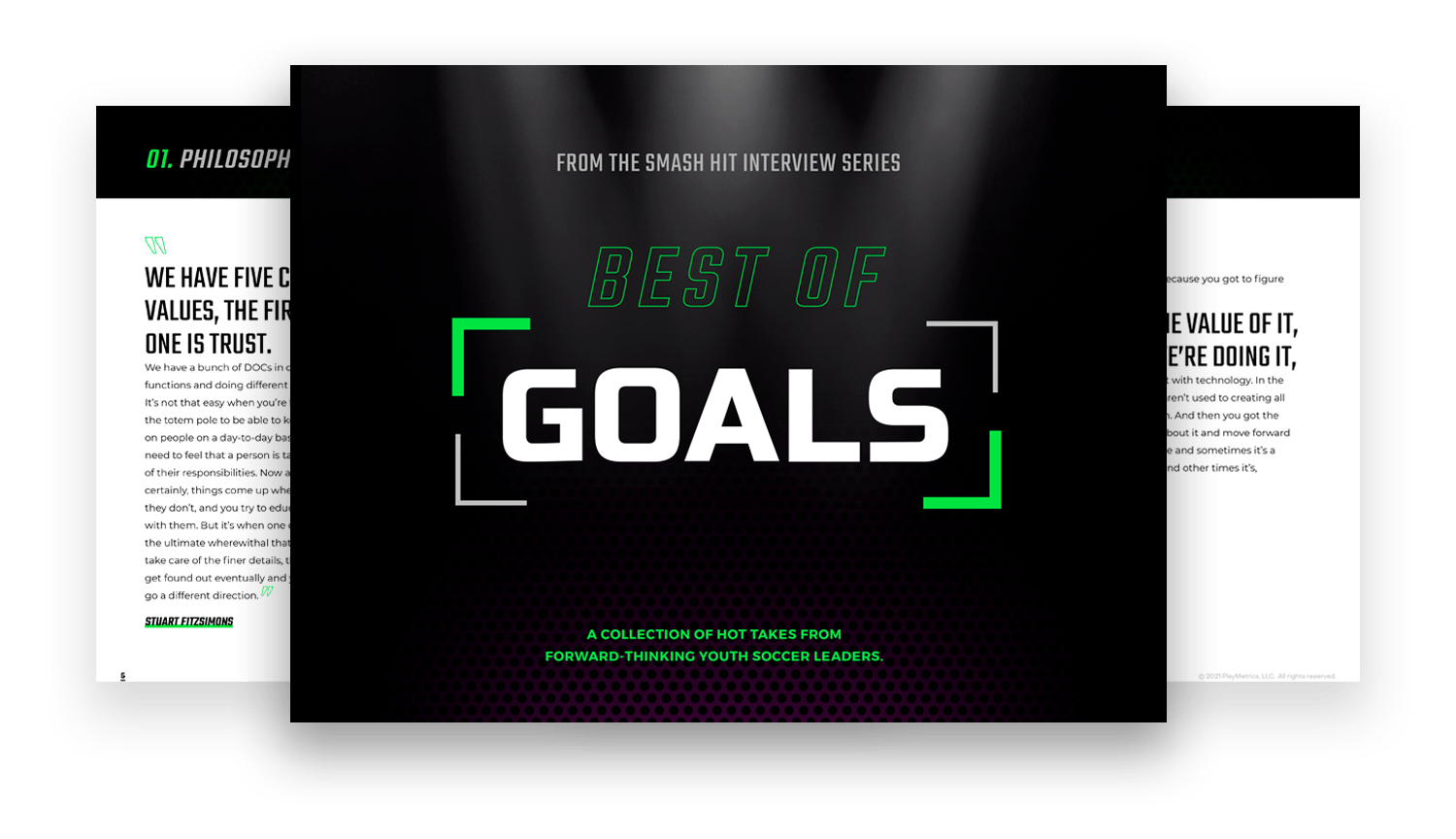
Get the “greatest hits” from all of the GOALS interviews. Download here.
Recent Posts


